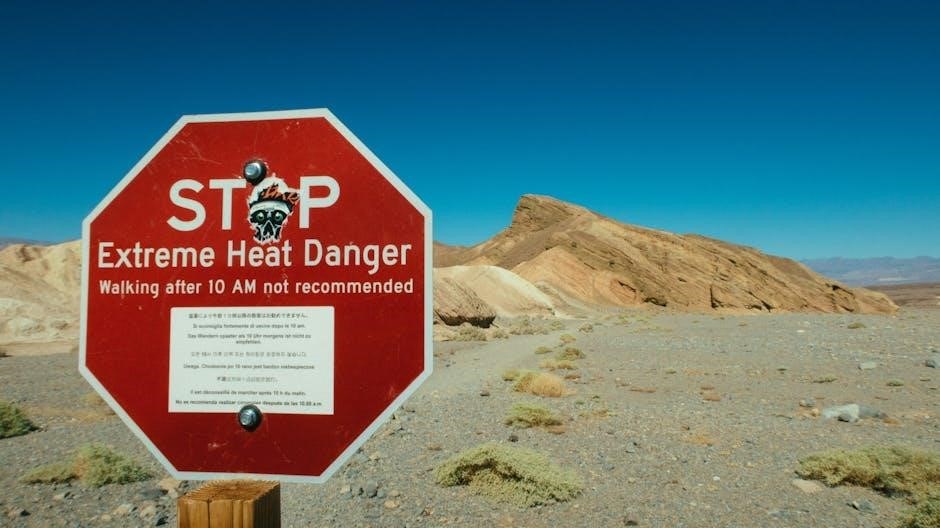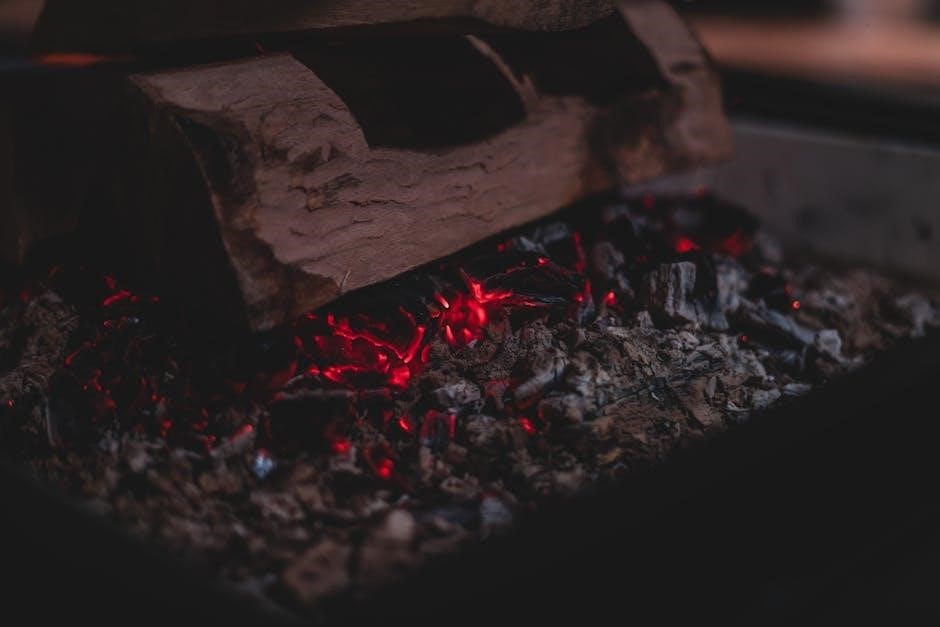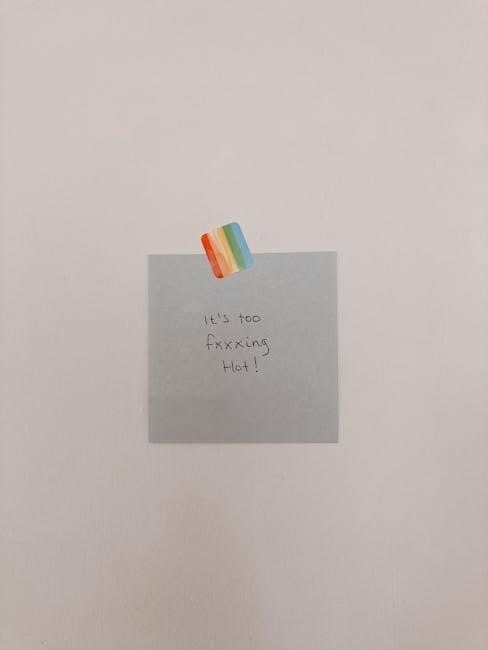Welcome to the Vevor Heat Press Temperature Guide, your ultimate resource for mastering heat pressing. This guide covers optimal temperature settings for various materials, ensuring precise results.
Whether working with fabric, glass, or metal, understanding temperature control is key. Discover how to achieve professional-quality transfers and designs with Vevor’s versatile heat press equipment.
Overview of the Vevor Heat Press
The Vevor Heat Press is a versatile and user-friendly machine designed for heat transferring on various materials. Known for its durability and precision, it offers adjustable temperature, pressure, and time settings, making it ideal for both beginners and professionals. With a robust build and intuitive controls, it supports a wide range of projects, from fabric printing to glass and metal customization. Its compact design and ease of use make it a popular choice for crafters and small businesses alike, ensuring high-quality results for diverse applications.
Equipped with advanced features like digital temperature control and a large pressing surface, the Vevor Heat Press is a reliable tool for achieving professional-grade transfers. Its versatility allows users to experiment with different materials and techniques, making it a standout option in the world of heat pressing.
Importance of Temperature Settings in Heat Pressing
Temperature settings are crucial in heat pressing, as they directly impact the quality and durability of the final product. Incorrect temperatures can damage materials, cause discoloration, or result in poor adhesion. Proper heat settings ensure optimal transfer of designs and prevent overheating or underheating, which can ruin the substrate or the applied material. Achieving the right balance is essential for professional-grade results, making temperature control a cornerstone of successful heat pressing projects.
Understanding and adjusting temperature settings according to the material being used is vital for achieving desired outcomes and extending the lifespan of both the heat press and the finished product.

Understanding the Basics of Heat Press Temperature
Heat press temperature determines the success of transfers. Proper settings vary by material type, pressing time, and pressure. Calibration ensures accuracy, optimizing results for each project.
How Heat Press Temperature Affects Different Materials
Heat press temperature significantly impacts material outcomes. Cotton and polyester require lower settings to prevent scorching, while thicker fabrics need higher temps for proper adhesion. Glass and metal demand precise, high-temperature control to achieve durable, long-lasting finishes. Incorrect settings can lead to under-cured or over-cured designs, affecting durability and appearance. Understanding material-specific temperature needs ensures optimal results and extends the life of your designs. Always refer to the Vevor Heat Press Temperature Guide for tailored settings to match your project requirements.
Basic Temperature Ranges for Common Materials
Cotton and polyester typically require temperatures between 270°F to 300°F, while thicker fabrics like canvas may need up to 320°F. Sublimation materials often range from 380°F to 400°F for optimal transfers. Glass and metal items usually require higher temperatures, around 350°F to 400°F, depending on the substrate. Heat transfer vinyl (HTV) generally falls between 280°F to 320°F; These ranges serve as a starting point, but exact settings may vary based on material thickness and desired results. Always test a small sample before pressing your final design.

Temperature Settings for Specific Materials
Cotton: 270°F–300°F, polyester: 280°F–310°F. Sublimation: 380°F–400°F. Adjust based on material thickness and layers for optimal results.
Cotton and Polyester Fabrics
Cotton and polyester fabrics are common for heat pressing. Cotton typically requires temperatures between 270°F–300°F, while polyester needs 280°F–310°F. These settings ensure proper adhesion without scorching. For blended fabrics, start with lower temperatures and adjust based on material thickness. Always test on scrap fabric first to avoid damaging your project. Proper time and pressure settings are also crucial for optimal results, balancing heat penetration without risking fabric damage.
Sublimation and Heat Transfer Vinyl (HTV)
Sublimation typically requires higher temperatures, around 380°F–400°F, with a press time of 3–4 minutes. Use a butta paper to prevent dye migration and ensure vibrant transfers. For HTV, temperatures range from 270°F–300°F, with a shorter press time of 10–15 seconds. Apply firm pressure and peel the vinyl while it’s cool for best results. Always test settings on scrap material first to achieve optimal outcomes without damaging your design or substrate.
Specialized Materials Like Glass and Metal
Heat pressing glass and metal requires precise temperature control to avoid damage. For glass, set the temperature between 300°F–350°F, using a heat-resistant tape to secure the material. Pressing time typically ranges from 30–60 seconds, depending on the glass type and thickness. Metal substrates usually require higher temperatures, around 350°F–400°F, with shorter pressing times of 15–30 seconds. Ensure proper ventilation and use a thermal tape to prevent overheating and achieve a durable, long-lasting finish.
Always pre-test settings on scrap material to avoid damaging your substrate or design. Adjust pressure according to the material’s sensitivity, as excessive force can scratch or bend metal and glass surfaces. Optimal results are achieved by maintaining consistent heat distribution and avoiding overheating, which can cause discoloration or warping.

Time and Pressure Settings: A Comprehensive Guide
Mastering time and pressure settings is crucial for achieving professional heat press results. Learn how to balance duration and force for optimal material handling and design longevity.
Adjustments vary by material type, ensuring proper adhesion without damage. This guide provides detailed insights to help you perfect your heat pressing technique effortlessly.

Optimal Time Duration for Heat Pressing
The optimal time for heat pressing varies based on material type and thickness. For most fabrics and heat transfer vinyl (HTV), 10-30 seconds is sufficient. Sublimation requires longer, typically 3-4 minutes, while thicker materials like glass or metal may need up to 5 minutes. Ensure the timer is set accurately to avoid under-heating or over-heating, which can damage designs or substrates. Always consult the material’s guidelines for precise timing to achieve durable, professional-quality results.
Adjusting time ensures proper adhesion without compromising material integrity, making it a critical factor in successful heat pressing projects.
Adjusting Pressure for Different Materials
Adjusting pressure is crucial for achieving optimal results in heat pressing. Light materials like cotton require medium pressure, while thicker fabrics or heat transfer vinyl (HTV) need higher pressure. Sublimation and metal blanks may require firm pressure to ensure proper transfer. Always refer to the material’s guidelines for specific pressure recommendations. Using too little pressure can result in incomplete adhesion, while excessive pressure may damage the substrate or design.
Test the pressure by applying a small sample first. Ensure even pressure distribution across the press to avoid uneven transfers. Proper pressure adjustment ensures long-lasting, professional-quality finishes.
Safety Tips for Using the Vevor Heat Press
Always wear protective gloves and eyewear when operating the heat press. Ensure proper ventilation to avoid inhaling fumes from materials. Keep children away during use;
Never leave the heat press unattended while in operation. Regularly inspect the machine for damage and ensure it is placed on a stable, heat-resistant surface.

Precautions to Avoid Accidents
When using the Vevor heat press, always wear heat-resistant gloves and protective eyewear. Ensure the workspace is clean and well-ventilated to prevent fume inhalation. Avoid loose clothing that could catch fire or get caught in the machine. Keep the heat press on a stable, heat-resistant surface away from flammable materials. Never overload the press, and avoid touching hot surfaces. Regularly inspect cables and components for damage. Maintain a safe distance from children and pets during operation. Follow the user manual guidelines strictly to minimize risks and ensure safe usage.
Proper precautions will help prevent accidents and ensure a safe, efficient heat pressing experience.
Proper Ventilation and Workspace Setup
Ensure your workspace is well-ventilated to prevent inhaling fumes from materials like vinyl or sublimation ink. Open windows or use an exhaust fan to maintain airflow. Place the heat press on a stable, heat-resistant surface, such as a ceramic tile or heat-resistant mat. Keep flammable materials, such as curtains or paper, away from the press. Organize your workspace to avoid clutter, ensuring easy access to tools and materials. Proper ventilation and a clean workspace are essential for safe and efficient heat pressing.
Additionally, keep a fire extinguisher nearby and ensure good lighting to monitor your work. A well-prepared workspace enhances safety and productivity while using the Vevor heat press.
Maintenance and Calibration of the Vevor Heat Press
Regularly clean the heat press surfaces and check for wear. Calibrate the temperature sensor periodically to ensure accuracy. Proper maintenance extends the lifespan and performance of the press.
Follow the manufacturer’s guidelines for calibration and maintenance to achieve consistent results and prevent operational issues over time.
How to Calibrate the Temperature Sensor
To calibrate the temperature sensor on your Vevor heat press, start by pressing the SETUP button once. The Temp light will turn red, indicating the device is in calibration mode. Next, use the /- key to adjust and set the desired heating temperature. This process ensures accuracy in temperature readings, which is crucial for consistent results.
After setting the temperature, allow the press to heat up and verify the accuracy with a thermometer. If needed, repeat the process to fine-tune the sensor for optimal performance.
Advanced Techniques for Heat Pressing
Master advanced heat pressing methods for multi-color designs and layered transfers. Explore using specialized attachments to enhance versatility and achieve intricate, professional-grade results with precision and ease.

Multi-Color and Layered Designs
Creating multi-color and layered designs with a Vevor heat press requires precise temperature control and timing. Start by pressing the base layer at a lower temperature to prevent damage. Gradually increase heat for subsequent layers, ensuring proper adhesion without overheating. Use a temperature range of 280-320°F for most fabrics. Apply a heat-resistant tape to align layers perfectly. For intricate designs, consider using sublimation inks or heat transfer vinyl. Experiment with attachments like the multi-spring press for even pressure distribution. Achieve vibrant, professional results by layering colors and materials with care.
- Use lower temperatures for base layers to avoid damage.
- Gradually increase heat for subsequent layers.
- Apply heat-resistant tape for precise alignment.
- Experiment with sublimation inks or HTV for vibrant colors.
Using Different Attachments for Versatility
The Vevor heat press offers versatility through interchangeable attachments, allowing you to work with various materials and projects. Attachments like the multi-spring press, hat press, and mug press enable precise heat transfer on curved or uneven surfaces. Each attachment is designed to distribute pressure evenly, ensuring consistent results. Experiment with different attachments to expand your creative possibilities, from custom apparel to personalized accessories. This flexibility makes the Vevor heat press a must-have tool for crafters and professionals alike.
- Interchangeable attachments for diverse project needs.
- Multi-spring press ensures even pressure on curved surfaces.
- Expand creativity with custom designs on various materials.

Troubleshooting Common Issues
Address common heat press challenges by adjusting temperature, pressure, and time settings. Ensure proper alignment, even pressure, and correct material settings. Consult the manual for calibration guidance.
Temperature Fluctuations and Solutions

Temperature fluctuations can disrupt heat pressing results, causing uneven transfers or material damage. Common causes include faulty sensors, incorrect settings, or poor calibration. To address this, ensure the heat press is preheated properly and maintain a stable workspace environment. Regularly calibrate the temperature sensor and check for software updates. If issues persist, consult the user manual or contact customer support for assistance. Proper ventilation and avoiding overheating can also help stabilize temperature performance, ensuring consistent and professional-quality outcomes.
Common Mistakes and How to Fix Them
Common mistakes when using the Vevor heat press include incorrect temperature settings, not calibrating the machine, and ignoring material-specific guidelines. To fix these, ensure proper calibration and preheating. Start with recommended temperatures but adjust based on material response. For instance, if using 310°F for glass cans doesn’t yield desired results, slightly increase the temperature. Always refer to the user manual and material guidelines for optimal settings. Regular maintenance and adherence to safety protocols can prevent errors and enhance overall performance.
The Vevor Heat Press Temperature Guide provides essential insights for mastering heat pressing. By following these guidelines, you’ll achieve professional results consistently. Remember to always calibrate, preheat, and adjust settings based on materials. Keep experimenting and learning to unlock the full potential of your Vevor heat press.
Best Practices for Achieving Professional Results
Achieving professional results with the Vevor Heat Press requires precise temperature control, proper pressure adjustments, and optimal time settings; Always calibrate the temperature sensor to ensure accuracy. For materials like cotton and polyester, use the recommended temperature ranges, while specialized materials such as glass and metal may need higher settings. Preheat the press and substrate before applying designs; Use the right pressure based on material thickness and type. For multi-color designs, apply layers sequentially, allowing each to cool before adding the next. Clean the press regularly and maintain a well-ventilated workspace. Experiment with different attachments for versatility and desired effects. Proper maintenance and adherence to these practices will ensure consistent, high-quality outcomes with your Vevor Heat Press.
Continuous Learning and Experimentation
Continuous learning and experimentation are crucial for mastering the Vevor Heat Press. As you explore different materials and techniques, refine your skills by testing various temperature, time, and pressure settings. Stay updated with online tutorials, forums, and guides to discover new methods. Experiment with multi-layered designs and specialized attachments to expand your creative possibilities. By applying knowledge and practicing regularly, you’ll enhance your results and unlock the full potential of your Vevor Heat Press, ensuring professional-quality outcomes every time;